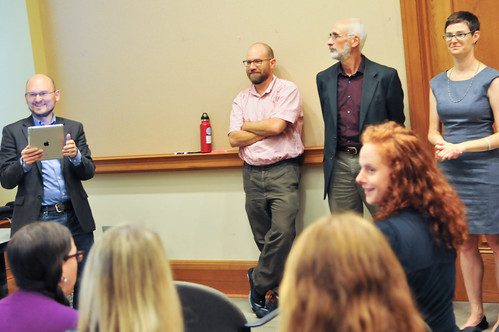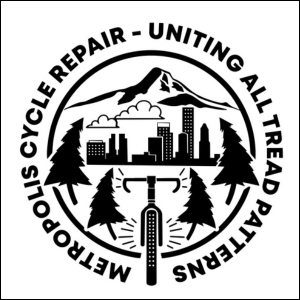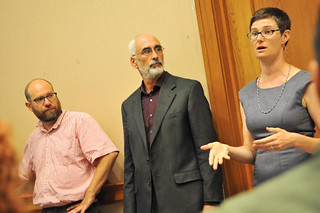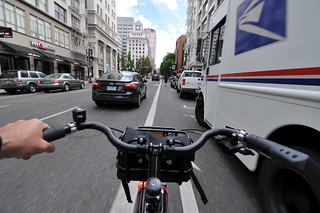
(Photos by J. Maus/BikePortland)
What happened to Portland? Did we really deserve to lose our spot atop the podium of America’s best bike cities? Is this whole stagnation thing for real?
“… the city is not stagnating in our efforts, the numbers are stagnating.”
— Roger Geller, PBOT
Those were the questions on everyone’s mind as the Portland Bureau of Transportation hosted a panel discussion titled, Are we really #4 last week as part of their monthly Lunch and Learn series. The panel featured three of the city’s smartest bike thinkers: PBOT Bicycle Coordinator Roger Geller, BTA Executive Director Rob Sadowsky, and Alta Planning Principal and Programs Manager Jessica Roberts. Moderator duties were put in the able hands of BikePortland News Editor Michael Andersen.
The event came on the heels of a one-two punch to the gut of PBOT: the #4 ranking from Bicycling Magazine and new U.S. Census numbers (revealed the morning of the panel) that showed a continued flatlining of Portland’s bike-to-work rate.
Timo Forsberg with PBOT’s Active Transportation Division opened the event by acknowledging that, “The Census numbers were not as good as we’d like.”
Forsberg was addressing a packed City Hall conference room. There were so many people the panelists had to give up their seats and stand. A quick scan of faces showed the room was full of influencers, from a Travel Portland staff member to neighborhood bike activists, to what looked like the entire staff of PBOT’s Active Transportation Division.
Advertisement
Before the real discussion started, Andersen had the panelists and the audience do a quick hand-raising exercise in response to several questions. “Will Portland reach its 25 percent mode split goal by 2030?” he asked, to which only two (non-panelist) hands went up — and one of them was Forsberg.
As for the #4 ranking, it was generally agreed that it doesn’t amount to much, technically speaking. But it does matter. Even PBOT’s Geller, who’s worked on bike planning at the City since the early 1990s, said it hurts our civic brand. “I can assure you that Travel Portland cares,” he said, “Losing that ranking will probably have an economic impact on the city.”
Roberts said the ranking is all about clicks, controversy and subscriptions for Bicycling Magazine. But she admitted that being #4 will hurt Portland’s ability to lead the national movement for better bicycling. Roberts also credited the magazine for “picking up on the collective awareness that other cities are gunning for our title.”
Given the lack of bold steps to improve bicycling in Portland in the past few years, it’s not hard to understand why we fell to #4. When Andersen asked the panel why Portland is no longer considered the cycling superpower it once was, the responses varied.
Sadowsky from the BTA pointed out that of the five top-ranked cities, Portland is the only one without a bike share system (bike share, he said, will cause a 3-4 percent jump in bike use within its first year of operation). Sadowsky also said our lack of a connected pathway system and a lack of protected bike lanes on major streets are other ways we lag behind New York City, Chicago, and Minneapolis.
For Geller, our slide is simply because we’re “Not showing the level of commitment and investment other cities are showing.” He echoed Sadowsky’s sentiments about the lack of high-quality protected bikeways through the central city by sharing the story of how pleasant it was to pedal all the way through Manhattan and Chicago’s downtown loop while conversing with a colleague.
“What we took 15 years to build, we saw that compressed to just a few years in New York and Chicago… They’re doing things faster, better, and with more fearlessness.”
— Jessica Roberts, Alta Planning and Design
“If we had developed some of the things we hoped to develop with our central city project,” Geller said, “we’d still be #1.” (Geller was referring to a $6.6 million Metro grant for downtown bikeways that is sitting on a shelf at PBOT.)
That being said, Geller pointed out that it’s much easier for New York City and Chicago to create protected bikeways because they have very wide streets. “We have harder decisions to make,” he said, referring to our narrow streets, “But we also have experienced the benefits of bicycling for a longer time, so we know better.”
Roberts said Portland is just too slow and cautious. “What we took 15 years to build, we saw that compressed to just a few years in New York and Chicago,” she said. Thanks in large part to strong-willed mayors (and a form of city government — unlike ours — that allows for it), Roberts said those cities are doing things “Faster, better, and with more fearlessness.”
Moving past the #4 ranking, the discussion then turned to Portland’s stubborn cycling statistics. “Why are we stagnating?” Andersen asked.
Both Roberts and Geller said it has a lot to do with infrastructure. We’ve attracted most of the riders, their thinking goes, who are fearless enough to use our current bikeways. “The next group of people that will get on bikes need more than we are offering them today,” is how Geller put it.
Then Geller laid out a new message from PBOT to counter the stagnation narrative. “I want to draw a distinction,” he said, “the city is not stagnating in our efforts, the numbers are stagnating.”
One of Sadowsky’s ideas about Portland’s ridership plateau supports Geller’s position. “Follow the jobs and the follow the housing,” he said. “Our economy changed rapidly in ’07 and ’08 and we’re still coming to terms with that.” (Learn more about how rental rates and housing have impacted cycling rates in our latest Real Estate Beat story.)
One culprit all three panelists pointed the finger at was the allure of single-occupancy vehicles, a.k.a. cars. Geller said the City hasn’t made good on promises in its Bike Plan for 2030 that passed four years ago. “Our policy says that we need to make bicycling more attractive than driving for trips three miles or less. We haven’t really done that yet,” he acknowledged. “It’s really easy to drive a car in this city.”
And Sadowsky concurred: “It’s not only easy to drive, it’s cheap. Parking rates are minimal here compared to other cities.”
“Our policy says that we need to make bicycling more attractive than driving… We haven’t really done that yet.”
— Roger Geller, PBOT
Surprisingly, there was no real discussion of how Portland’s current political dynamic at City Hall figures into our stagnation equation (it does). Nor was there any talk of a related issue: the gap that exists in the local advocacy/activism ecosystem (a topic that we’ve discussed at length here on the Front Page).
In the end, I don’t think anyone walked away from this event feeling like everything had been figured out. The event did however mark an important moment: I think it’s safe to say that Portlanders (its city staff, its advocates, and so on) have admitted we have a problem. That’s the first step toward recovery.
And Roberts, a former advocate with the BTA before finding success at Alta, said what really matters now are the next steps we choose to take. “Everyone hates the incumbent and everyone is sick of hearing about Portland,” she said, “This inspires us to push harder and get our edge back. If we turn it around with humility and energy, that will be a way bigger story than going from #1 to #4.”
— Read more about Portland’s cycling stagnation in our archives.




